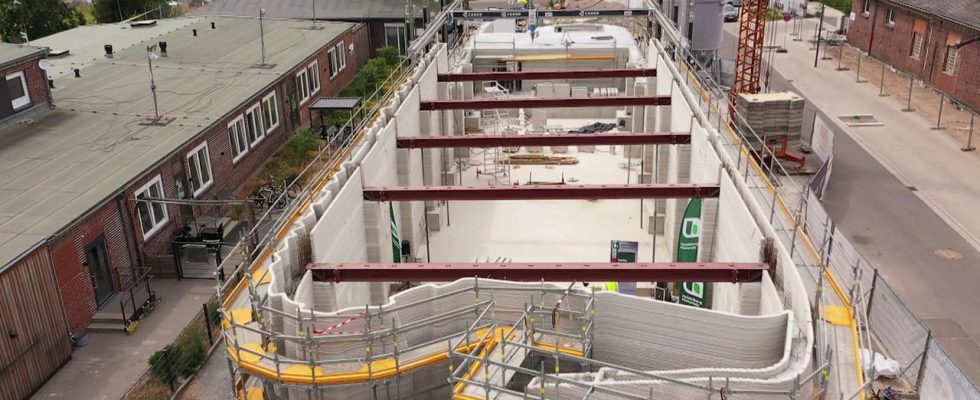Are houses from the 3D printer revolutionizing the construction industry? The largest 3D building in Europe has just been completed in Heidelberg. It was created within 140 hours.
Layer by layer instead of stone on stone. The house is finished within 140 hours – at least the printer’s work, explains Hans-Jörg Kraus, managing partner of the Kraus Group, who commissioned it.
It will be a data center. It was created in Heidelberg, on the site of the former headquarters of the American armed forces in Europe. 53 meters long, eleven meters wide and nine meters high – the largest printed building in Europe. Printing started in April, this week the last concrete ink flowed.
Passion for 3D printing
Kraus is fascinated by 3D printing. In 2020, the first house in Germany was printed in Beckum, North Rhine-Westphalia. When he heard about it, he thought, “I want that too.” Now the time has come, his server hotel is the third fully approved 3D printed building in Germany. “I’ve always had an enormous play instinct. And that’s exactly what drives me here with the 3D printing process,” says Kraus, his eyes shining.
It was an unusual construction site: not many machines made the noise, but a single so-called portal printer. Squeaking and rattling, he pressed a layer of concrete onto the one below using a hose and a pressure nozzle. Almost like squirting cream onto a cake from a spout. The walls are wavy, from above it looks like a rectangle with curves. Such forms are not possible in conventional construction.
Like cream being squirted onto a cake from a spout: the pressure nozzle lines up layer of concrete on top of layer of concrete.
Build printer more environmentally friendly?
Another advantage: The special concrete used has a significantly smaller CO2 footprint and is recyclable. Kraus’ vision: “That in a few years we’ll be able to tear down this building, shred it, recycle it and print a new building using renewable energies.”
Robert Jahn from the Technical University of Dresden is researching 3D printing. He too is enthusiastic; However, he doesn’t find the concrete used to be quite that environmentally friendly – because the material may have come from far away. The Heidelberg Materials subsidiary Italcementi has developed a cement especially for 3D printing. Among other things, it must be easily pumpable and ejectable. So it is not yet a standard material that is available in many places. “In some cases, longer transport routes may arise,” he says.
For the construction site in Heidelberg, however, the distance is limited. In the last two years, the company Heidelberg Materials has set up a production site in North Rhine-Westphalia, from where the 3D printed concrete for the construction site in Heidelberg comes.
New requirements for construction workers
Standard concrete was also used here. A construction worker placed anchors by hand between the partially parallel walls that the robot printed. Then the normal concrete was poured into the gap, currently still a specification of the statics. “In the future, the walls alone should be stable enough, but the technology isn’t that advanced yet,” says Kraus.
Only three to four people were needed on the construction site to support the robot arm or to monitor what is happening. This is a great advantage of the 3D printing process in relation to the shortage of skilled workers, explains Kraus. 3D printing would also completely change the job requirements. You could already see that here: the construction workers have a spatula or trowel in one hand and their laptop in the other.
Printing standard soon?
But how quickly will the profession really change, how soon will our houses come off the printer as standard? According to Jahn from the Technical University of Dresden, this will take some time. The liquid concrete, which is pressed through a pressure nozzle, does not yet have a standard approval. You have to apply for a new one for each house.
In addition, the portal systems currently in use are significantly larger than the buildings to be constructed. In the highly dense inner-city area, where, for example, a vacant lot is to be closed and multi-storey buildings are to be built, it is still to be investigated whether the current technology can be used in this form. “Basically, I think that concrete 3D printing will be used more for prestige objects in the near future,” says Jahn.
As is currently the case in Heidelberg. Even during the printing they had masses of visitors here. Kraus is convinced of 3D printing. When asked what the disadvantages are, he says: “That we haven’t had any experience with it yet. That means we don’t even know what we might have to face in the next few years. But there will be solutions for that too. And that’s why it’s very important that we continue to experiment with this process.” Life always has a risk. And if you always do everything the same way just because you know it, life is far too boring.

